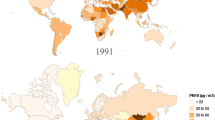Abstract
The main objective of this study was to develop parsimonious empirical models for predicting the mass and number concentrations of ultrafine particulate (UFP, aerodynamic diameter < 0.1 or 0.18 μm) in the atmospheric environment. We found strong correlations existed between the mass/number concentration of UFP and the mass concentration of PM2.5 (aerodynamic diameter < 2.5 μm) by fitting the experimental data. Therefore, we were easily able to obtain UFP mass and number concentrations by using the presented empirical models. The empirical equations should be used with care since limitations existed.

Similar content being viewed by others
References
Chio CP (2005) Chemical compositions and source apportionment of PM2.5 and PM2.5–10 aerosols in urban and coastal areas in central Taiwan. PhD Thesis, National Chung Hsing University, Taichung
Chio CP, Cheng MT, Wang CF (2004) Source apportionment to PM10 in different air quality conditions for Taichung urban and coastal areas, Taiwan. Atmos Environ 38:6893–6905
Chio CP, Chen SC, Chiang KC, Chou WC, Liao CM (2007) Oxidative stress risk analysis for exposure to diesel exhaust particle-induced reactive oxygen species. Sci Total Environ 387:113–127
Fang GC, Wu YS, Rau JY, Huang SH (2006) Traffic aerosols (18 nm ≤ particle size ≤ 18 μm) source apportionment during the winter period. Atmos Res 80:294–308
Fruin S, Westerdahl D, Sax T, Sioutas C, Fine PM (2008) Measurements and predictors of on-road ultrafine particle concentrations and associated pollutants in Los Angeles. Atmos Enivron 42:207–219
Hung HF, Wang CS (2001) Experimental determination of reactive oxygen species in Taipei aerosols. J Aerosol Sci 32:1201–1211
Ibald-Mulli A, Wichmann HE, Kreyling W, Peters A (2002) Epidemiological evidence on health effects of ultrafine particles. J Aerosol Med 15:189–201
Keeler GJ, Morishita M, Young LH (2005) Characterization of complex mixtures in urban atmospheres for inhalation exposure studies. Exp Toxicol Pathol 57:19–29
Lin CC, Chen SJ, Huang KL, Hwang WI, Chang-Chien GP, Lin WY (2005) Characteristics of metals in nano/ultrafine/fine/coarse particles collected beside a heavily trafficked road. Environ Sci Technol 39:8113–8122
Maynard AD, Kuempel ED (2005) Airborne nanostructured particles and occupational health. J Nanopart Res 7:587–614
Morishita M, Keerler GJ, Wagner JG, Marsik FJ, Timm EJ, Dvonch JT, Harkema JR (2004) Pulmonary retention of particulate matter is associated with airway inflammation in allergic rats exposed to air pollution in urban Detroit. Inhal Toxicol 16:663–674
Nel A (2005) Air pollution-related illness: effects of particle. Science 308:804–806
Nel A, Xia T, Mädler L, Li N (2006) Toxic potential of materials at the nanolevel. Science 311:622–627
Ntziachristos L, Ning Z, Geller MD, Sheesley RJ, Schauer JJ, Sioutas C (2007) Fine, ultrafine and nanoparticle trace element compositions near a major freeway with a high heavy-duty diesel fraction. Atmos Environ 41:5684–5696
Oberdörster G, Oberdörster E, Oberdörster J (2005) Nanotoxicology: An emerging discipline evolving from studies of ultrafine particles. Environ Health Perspect 113:823–839
Samet JM, Dominci F, Curriero FC, Coursac I, Zeger SL (2000) Fine particulate air pollution and mortality in 20 US cities, 1987–1994. New England J Med 343:1742–1749
Acknowledgments
This work was supported by the National Science Council, ROC through grant number NSC88-EPA-Z-005-003.
Author information
Authors and Affiliations
Corresponding author
Rights and permissions
About this article
Cite this article
Chio, CP., Cheng, MT., Lin, YC. et al. Empirical Models to Predict Parsimoniously the Mass and Number Concentrations of Ultrafine Particulate in Ambient Atmosphere. Bull Environ Contam Toxicol 83, 688–692 (2009). https://doi.org/10.1007/s00128-009-9821-6
Received:
Accepted:
Published:
Issue Date:
DOI: https://doi.org/10.1007/s00128-009-9821-6




